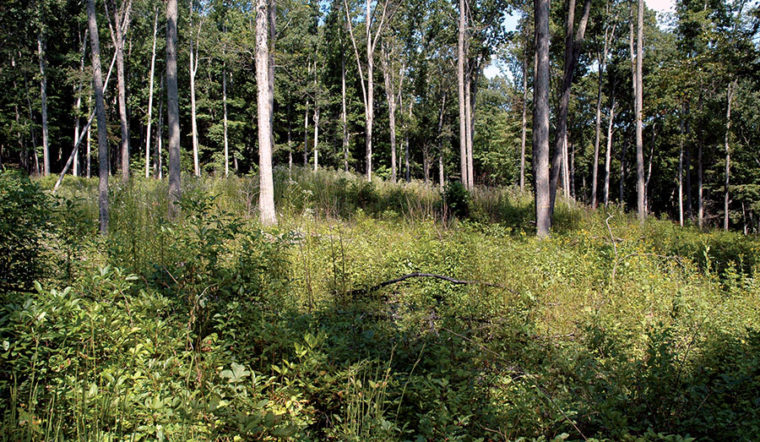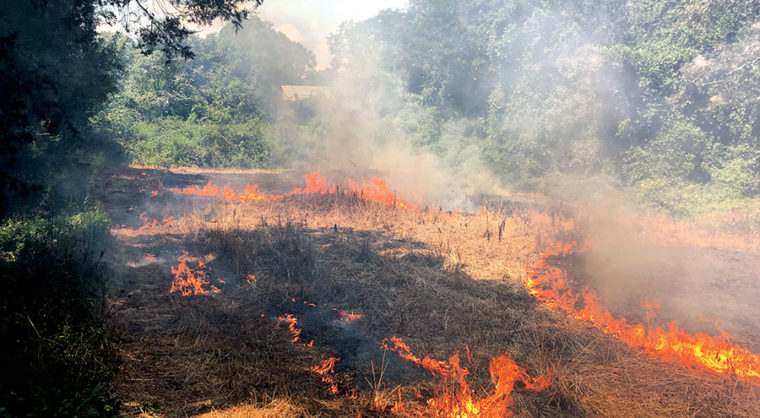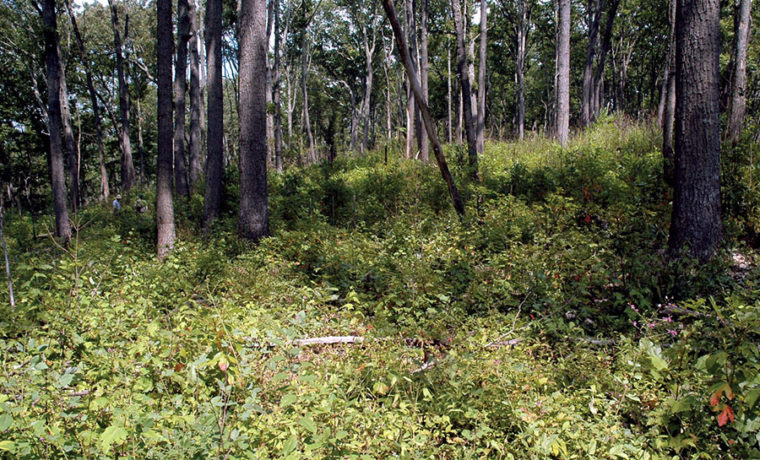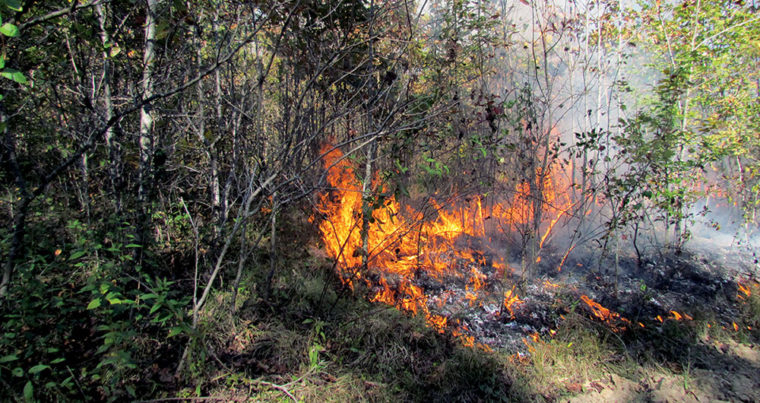This is not the same old advice you’ve heard before about prescribed fire. These simple tips will increase your hunting and habitat management success.
I continue to maintain that fire is the single best management tool to enhance deer habitat in most areas of the country. Fire is commonly recommended to set back succession in “old fields” and to influence understory plant composition and structure in forests and woodlands. However, there are several ways fire can be used to enhance habitat and increase hunting success that you might not have considered.
Let’s first review how fire is typically used and the usual result. Then we’ll look at several ways you can diversify your use of fire and improve results.
Typical Methods and Results
In the eastern United States, where we receive 30-plus inches of rain annually, fields become dominated by young trees usually within 6 years if succession is not set back by fire, herbicide applications or mechanical treatment. Relatively frequent fire can maintain an early successional community dominated by herbaceous plant species that provide high-quality forage and cover for both fawns and adult deer.
Most often, fields are burned during the dormant season or early in the growing season (late winter to early spring) on bluebird days with low humidity – in the 25 to 30% range – and bright sunshine heating and drying the dead plant material in the field. It is easy to burn then, and you have to be prepared with good firebreaks around the area you are burning to prevent fire from spreading into unwanted areas.
This type of broadcast burning maintains an early successional plant community, but it can result in a relatively homogenous structure and, if fire is perpetually implemented in this same manner and at this same time of year on a frequent interval of every one to three years, the plant community usually becomes dominated by perennial warm-season grasses and a few perennial forbs. If the frequency is lengthened, woody sprouts dominate. They are top-killed by the fire but resprout with vigor. All of this may be good, and it may fit your objectives, especially for fawning cover, but forage quality across the field is relatively low.
Let’s go in some different directions.

Above is a 2-acre foraging patch that is burned every two years to maintain high-quality forage for deer in the woods. It is essentially a natural food plot in the woods, maintained by frequent fire. By having such patches distributed throughout a property, even one that is primarily forested, the nutritional carrying capacity is significantly increased. Note that high-quality oaks that produce acorns have been retained in the patch. Low-intensity fire does not harm these trees.
A Little Help from Herbicides in Old-Fields
An alternative is to burn during the growing season. And I’m talking about on into the growing season like July through September, not April through June. However, burning at this time can be difficult. Plant biomass during summer may be more than 80% water. Unless it is exceptionally dry and there is a lot of dead biomass from previous years in the field, it may be impossible to burn.
You can help the situation by spot-spraying undesirable plants in the field, including undesirable tree seedlings and saplings, to create dead plant material that will burn even if the rest of the field will not burn. I use glyphosate to spot-spray fields in early to mid-summer. By doing so, I create dead patches here and there. I then go through the field with a drip-torch and burn the dead patches. After a couple rains, fresh growth from the seedbank sprouts. Annual forbs commonly respond, which provide nutritious forage during mid- and late summer.
Burning such patches also creates a variable structure with annual plants growing in patches that were sprayed and burned within a field of perennial forbs and grasses, brambles, and perhaps desirable sprouting trees and shrubs. Unless conducted during an exceptionally dry period, you don’t need a firebreak to contain the fire. You can burn the dead material during conditions that will not allow the fire to spread beyond the dead patches.

Undesirable plants in old-fields can be spot-sprayed in mid-summer. Two to three weeks after spot-spraying, dead patches can be burned, stimulating fresh, nutritious forage. These small burn patches in old-fields act much as small warm-season food plots. These small patches can be hot spots for deer foraging in late summer during bow season.
You also can spray strips, and these strips might coincidentally lead to or be within view of a stand site near the edge of the field! If strips are sprayed in June and burned in July, you would allow natural revegetation. If sprayed in early August, you might no-till top-sow your favorite annual food plot mixture to provide a lush neon-green strip of high-quality forage in the field in fall and winter after the natural forages have died, but still provide attractive cover because you left the cover standing instead of mowing it!
Believe me, if you try this, your strategy of managing fields and hunting will change forever.
Food Plot Applications
You can use fire to create a perfect seedbed for your food plots, especially new food plots in old-fields or when renovating overgrown, old perennial plots. Spray existing vegetation two to three weeks before you intend to plant, then burn the dead plant material. You can no-till top-sow small seed, such as clovers, brassicas or wheat after burning. Cultipacking after planting will help. You also can spread lime and fertilizer according to soil-test recommendations at that time.
If you are looking to increase organic matter, do not burn the organic material. Instead, you should no-till top-sow small seed after spraying, then mow or roll the dead plant material. Of course, you also could drill seed if you have a no-till drill.

Dead thatch in this plot was burned in late August, and the fire completely consumed the thatch and was out in seven minutes. After burning, the plot can be planted via no-till top-sowing followed with cultipacking.
Maintain Bedding Blocks
Fire is the perfect tool to maintain dense cover of young, regenerating trees to hold deer on your property, and it’s much easier than a chainsaw! Dormant-season fire is perfect because you can burn with full sunlight reaching the ground when the leaves are off the trees and easily burn hot enough to top-kill young trees and keep the structure dense to hold deer. The objective is to continue to top-kill the trees and allow them to resprout and maintain dense cover over time.
In most areas, a six to eight-year fire-return interval works very well. If you wait longer, the trees will begin to reach diameters of 4 inches or more at ground level, making it more difficult to top-kill them. The cover value will begin to diminish as the stand begins to open up with increased visibility. Remember, your intention is to maintain dense woody cover, not necessarily increase forage, though increased browse will be available two to four years after burning.
Maintain High-Quality Forage in Fields
Frequent burning every one to three years helps maintain high-quality forage in fields. However, light disking every few years following fire will stimulate more annual forbs, thus increasing forage quality. If you burn relatively large fields, you might consider disking a portion of the field and rotate disking into different parts of the field after subsequent burns to prevent perennial species from dominating. If annual grasses are a problem, a preemergence application of an imazapic herbicide will produce a more desirable plant community.
Attracting Deer With Fire
Burning large areas is not necessary to attract deer. What is the smallest food plot you have ever planted and killed a deer in? How is that different from burning a small section of an old-field near or in view of your stand site?
Small areas of a field – and by “small” I mean a tenth to half an acre – burned in mid to late summer may be particularly attractive before frost, especially if the current growth is relatively rank and was sprayed as discussed previously.
The same is true in woods. In his research that was previously featured in Quality Whitetails and at the NDA website, Dr. Marcus Lashley outlined how to attract deer for bowhunting by using fire in mid-summer in forests and woodlands. Regenerating sprouts following fire are palatable, nutritious and strongly attractive to deer. Small areas in woods are easily burned by using a backpack blower to create a firebreak. You can do this!

Firebreaks in woods can be created easily with a backpack blower. This simple technique allows you to burn relatively small areas in woods, such as the half-acre seen above, for increased forage.
Southside Management
Aspect is an important consideration when using fire in woods. South- and west-facing slopes are driest and most ecologically suited for burning. When working in areas with topography, I commonly clear or thin trees on the sunny slopes and burn them regularly for enhanced forage and cover. Deer commonly select these areas for bedding during midday in winter.
Getting Started
If you are not experienced with prescribed fire, you may be hesitant to burn. You want to, but you’re just not comfortable using fire because you have never done it before. I understand that. In fact, your hesitancy is good. You should be careful when using fire, just like you should be careful when operating a chainsaw or driving a car, ATV or tractor.
Now, familiarize yourself a little more about using fire. Your state forestry agency and state Prescribed Fire Council websites are great places for information. Additionally, two of my articles are available on this website – “Get Ready to Use Prescribed Fire” and “Four Ways to Light Prescribed Fire”.
Consider getting a few friends to help you, and start small! You can clear a firebreak with a disk, a backpack sprayer, a rake, or a backpack blower and burn a tenth of an acre, whether in a field or in the woods, and start getting some experience. You can learn a lot about fire behavior by burning small areas only 10 feet square, surrounded by a firebreak, during different seasons and conditions. I routinely test fire behavior in the woods and field behind my house throughout the year in all but extreme conditions just to see how fire behaves in different seasons. If you do this, you will be much more knowledgeable and comfortable when managing your fields and woods with fire.
